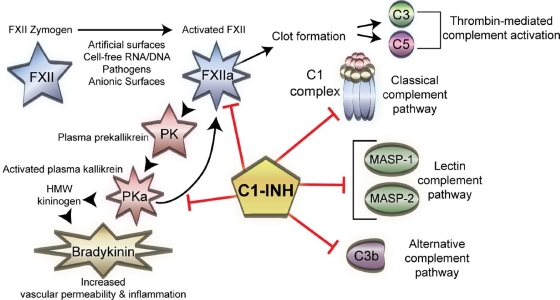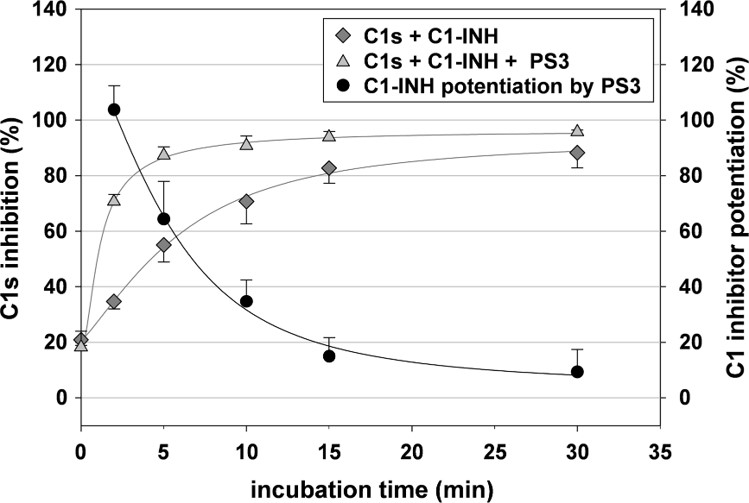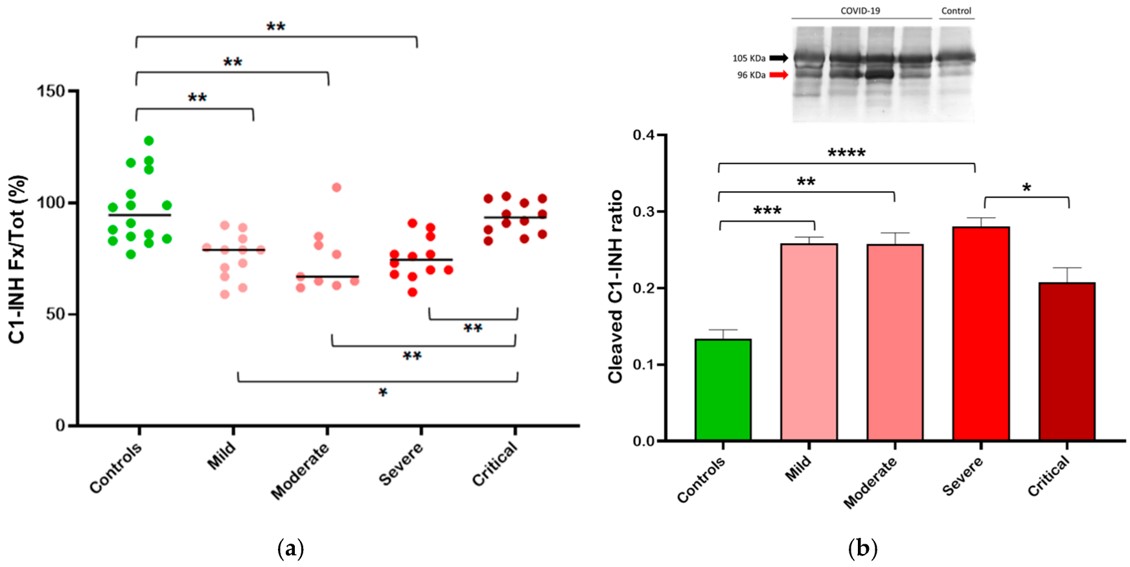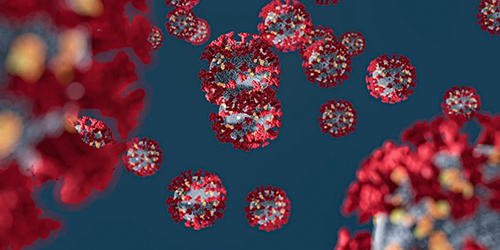Overview Workflows Case study Related Products Featured Services Protocols Q&A Resources
With many years of experience in complement research, Creative Biolabs provides first-class personalized complement C1 inhibitor (C1-INH) functional test services to support your complement research program.
Overview of Complement C1 Inhibitor Functional Test
Complement C1 Inhibitor
C1-INH is a glycoprotein that regulates the classical complement pathway and several other protease cascades, such as the coagulation system. It functions by inhibiting C1r and C1s, components of the C1 complex, preventing overactivation of the complement system. Structurally, C1-INH is a serine protease inhibitor (serpin) characterized by a single polypeptide chain that is stabilized by several disulfide linkages. It is crucial in maintaining immune homeostasis and controlling excessive inflammation or potential tissue damage.
 Fig.1 The classical pathway of the complement system and structure of the C1 complex.1,4
Fig.1 The classical pathway of the complement system and structure of the C1 complex.1,4
Complement C1 Inhibitor Functional Test
Method
The C1-INH functional test measures the activity and functionality of the C1-INH protein within plasma. The test evaluates how well C1-INH inhibits the classical complement pathway, particularly its ability to inhibit C1r and C1s proteases. The assessment of C1-INH function can be performed using two primary methods: a chromogenic assay and a complex-forming enzymatic immunoassay (ELISA).
Analysis
The C1 Complex functional test is crucial for diagnosing complement deficiencies, particularly in conditions like hereditary C1q deficiency or autoimmune disorders. It helps assess immune response efficiency and complement-mediated inflammation, guiding treatment decisions for complement-related diseases or immune system dysfunctions.
Workflow of C1 Inhibitor Functional Test
Chromogenic assay
The chromogenic assay utilizes a synthetic substrate specific to C1s, which allows the detection of C1-INH activity by measuring the reduction or absence of color formation in plasma samples, indicating effective inhibition of C1s.

Complex-forming ELISA
The complex-forming ELISA focuses on detecting the formation of a C1-INH-C1s complex, thereby providing an indirect measurement of C1-INH activity without assessing the actual inhibitory effect on C1s.

Case Study
 Fig.2 C1s inhibition by C1-INH determined by chromogenic substrate assay.2,4
Fig.2 C1s inhibition by C1-INH determined by chromogenic substrate assay.2,4
 Fig.3 Measurement of C1-INH plasma levels with ELISA in COVID-19.3,4
Fig.3 Measurement of C1-INH plasma levels with ELISA in COVID-19.3,4
Related Products
Featured Services

|

|
|
Total Complement Activity Test
|
C1q-Binding Assays
|
|
Creative Biolabs offers total complement activity test services for our clients. Total complement activity tests include CH50, AH50, and LP50.
|
Creative Biolabs offers high-quality C1q-binding assays for the characterization of therapeutic mAbs.
|
|
Learn more
|
Learn more
|
Protocols
Questions & Answer
A: C1-INH functional tests typically require human plasma or serum samples. The samples should be collected in appropriate anticoagulant tubes (such as citrate or EDTA) to prevent clotting and stored at -20°C or colder for long-term preservation. Proper sample handling is essential to guarantee consistent and precise results.
A: The estimated cycle for completing the C1-INH functional test typically ranges from 3 to 7 business days. This timeframe includes sample collection, processing, testing, and reporting. However, it may differ based on the sample's complexity, the specific testing protocols, and the laboratory's workload. It is always advisable to confirm the expected timeline with us to ensure accurate delivery and potential variations.
A: Our C1-INH functional test offers higher sensitivity and specificity, effectively reducing the likelihood of false positives. It is also more reproducible and can detect subtle functional deficiencies, improving diagnostic accuracy for conditions like hereditary angioedema. Additionally, it is faster and easier to perform compared to traditional assays.
A: Both the chromogenic and ELISA methods assess C1-INH activity by measuring its ability to inhibit target proteases. However, the chromogenic method uses a substrate that produces a color change upon enzyme cleavage, providing a direct measure of activity. ELISA, on the other hand, involves antigen-antibody interactions to quantify C1-INH levels. The chromogenic method is faster and more sensitive, while ELISA can offer more quantitative results.
Resources
The C1-INH functional test service at Creative Biolabs delivers precise, reproducible results to support cutting-edge research. With advanced technology, expert insights, and fast, reliable turnaround, we empower researchers to make breakthroughs with confidence and accuracy. For further details, please contact us.
References
-
Hausburg, Melissa A., et al. "C1 esterase inhibitor-mediated immunosuppression in COVID-19: friend or foe?." Clinical Immunology Communications 2 (2022): 83-90.
-
Schoenfeld, Ann-Kathrin, Eric Lahrsen, and Susanne Alban. "Regulation of complement and contact system activation via C1 inhibitor potentiation and factor XIIa activity modulation by sulfated glycans–Structure-activity relationships." PLoS One 11.10 (2016): e0165493.
-
Berra, Silvia, et al. "Patterns of C1-Inhibitor Plasma Levels and Kinin–Kallikrein System Activation in Relation to COVID-19 Severity." Life 14.12 (2024): 1525.
-
Distributed under Open Access license CC BY 4.0, without modification.
For Research Use Only.
Related Sections:

 Fig.1 The classical pathway of the complement system and structure of the C1 complex.1,4
Fig.1 The classical pathway of the complement system and structure of the C1 complex.1,4


 Fig.2 C1s inhibition by C1-INH determined by chromogenic substrate assay.2,4
Fig.2 C1s inhibition by C1-INH determined by chromogenic substrate assay.2,4
 Fig.3 Measurement of C1-INH plasma levels with ELISA in COVID-19.3,4
Fig.3 Measurement of C1-INH plasma levels with ELISA in COVID-19.3,4




